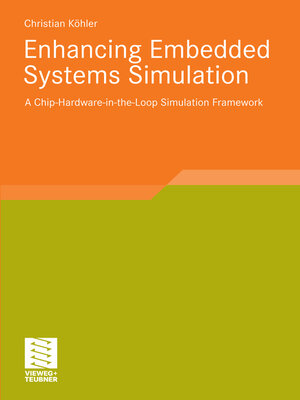Enhancing Embedded Systems Simulation
ebook ∣ A Chip-Hardware-in-the-Loop Simulation Framework
By Christian Köhler

Sign up to save your library
With an OverDrive account, you can save your favorite libraries for at-a-glance information about availability. Find out more about OverDrive accounts.
Find this title in Libby, the library reading app by OverDrive.



Search for a digital library with this title
Title found at these libraries:
| Library Name | Distance |
|---|---|
| Loading... |
Using the real Microcontroller (μC) as a replacement for a μC model inside a system simulation of a μC-based system is a big benefit since the μC is already verified. Moreover, its maximum performance and its accuracy are much higher than any simulation model.
With the Chip-Hardware-in-the-Loop Simulation (CHILS) approach, Christian Köhler covers the connection between μC and simulation, the analysis and optimization of such coupling systems as well as the interface abstraction. He develops the hardware to simulation coupling system with a focus on less hardware effort, the capabilities to couple with different simulation environments, and the efficiency of coupling. The interface abstraction primarily supports the efficiency of coupling. The system analysis and optimization concepts include formal criteria to determine the fidelity of Hardware-in-the-Loop (HIL) coupling systems, stability analysis of coupling systems, and the numerical analysis of applied software algorithms. Furthermore, the author presents existing concepts to simulate complex systems and compares them with the new approach.
With the Chip-Hardware-in-the-Loop Simulation (CHILS) approach, Christian Köhler covers the connection between μC and simulation, the analysis and optimization of such coupling systems as well as the interface abstraction. He develops the hardware to simulation coupling system with a focus on less hardware effort, the capabilities to couple with different simulation environments, and the efficiency of coupling. The interface abstraction primarily supports the efficiency of coupling. The system analysis and optimization concepts include formal criteria to determine the fidelity of Hardware-in-the-Loop (HIL) coupling systems, stability analysis of coupling systems, and the numerical analysis of applied software algorithms. Furthermore, the author presents existing concepts to simulate complex systems and compares them with the new approach.







